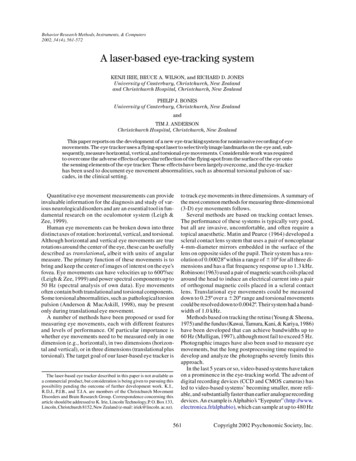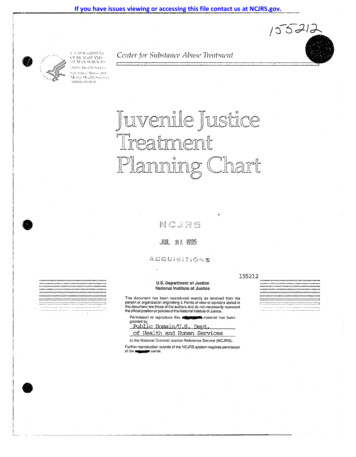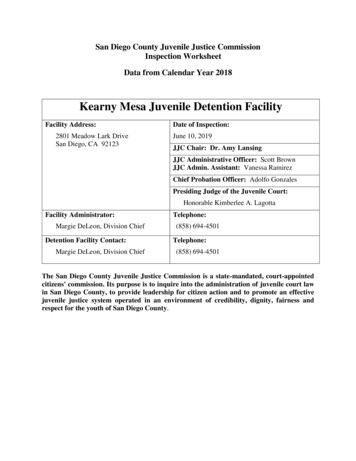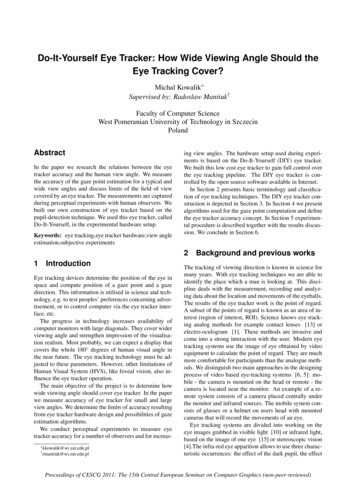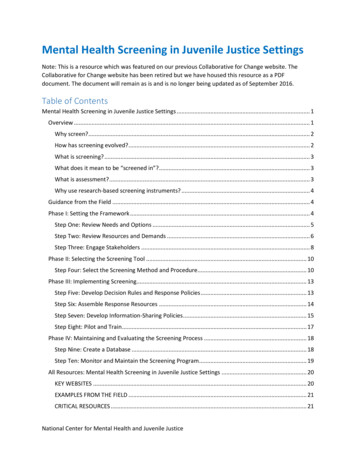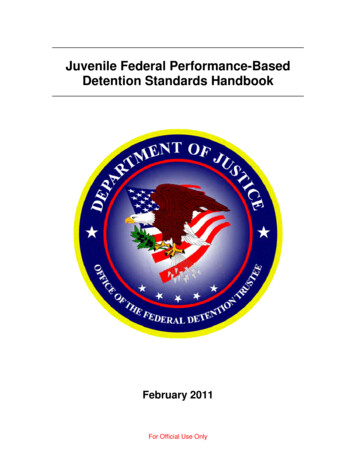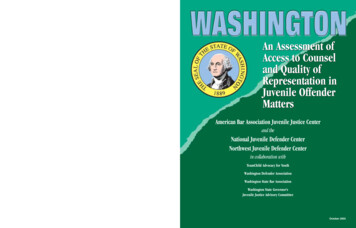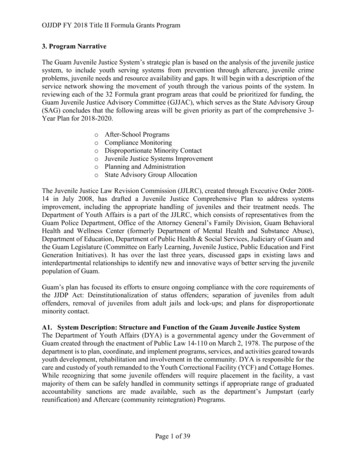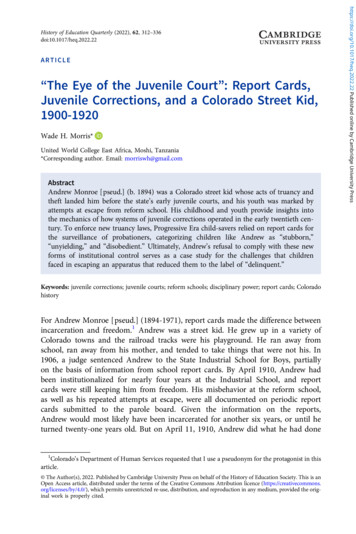
Transcription
ARTICLE“The Eye of the Juvenile Court”: Report Cards,Juvenile Corrections, and a Colorado Street Kid,1900-1920Wade H. Morris*United World College East Africa, Moshi, Tanzania*Corresponding author. Email: morriswh@gmail.comAbstractAndrew Monroe [pseud.] (b. 1894) was a Colorado street kid whose acts of truancy andtheft landed him before the state’s early juvenile courts, and his youth was marked byattempts at escape from reform school. His childhood and youth provide insights intothe mechanics of how systems of juvenile corrections operated in the early twentieth century. To enforce new truancy laws, Progressive Era child-savers relied on report cards forthe surveillance of probationers, categorizing children like Andrew as “stubborn,”“unyielding,” and “disobedient.” Ultimately, Andrew’s refusal to comply with these newforms of institutional control serves as a case study for the challenges that childrenfaced in escaping an apparatus that reduced them to the label of “delinquent.”Keywords: juvenile corrections; juvenile courts; reform schools; disciplinary power; report cards; ColoradohistoryFor Andrew Monroe [pseud.] (1894-1971), report cards made the difference betweenincarceration and freedom.1 Andrew was a street kid. He grew up in a variety ofColorado towns and the railroad tracks were his playground. He ran away fromschool, ran away from his mother, and tended to take things that were not his. In1906, a judge sentenced Andrew to the State Industrial School for Boys, partiallyon the basis of information from school report cards. By April 1910, Andrew hadbeen institutionalized for nearly four years at the Industrial School, and reportcards were still keeping him from freedom. His misbehavior at the reform school,as well as his repeated attempts at escape, were all documented on periodic reportcards submitted to the parole board. Given the information on the reports,Andrew would most likely have been incarcerated for another six years, or until heturned twenty-one years old. But on April 11, 1910, Andrew did what he had done1Colorado’s Department of Human Services requested that I use a pseudonym for the protagonist in thisarticle. The Author(s), 2022. Published by Cambridge University Press on behalf of the History of Education Society. This is anOpen Access article, distributed under the terms of the Creative Commons Attribution licence (https://creativecommons.org/licenses/by/4.0/), which permits unrestricted re-use, distribution, and reproduction in any medium, provided the original work is properly cited.https://doi.org/10.1017/heq.2022.22 Published online by Cambridge University PressHistory of Education Quarterly (2022), 62, 312–336doi:10.1017/heq.2022.22
313Figure 1: Truant boys, appearing before one of Colorado’s juvenile courts, around the same time thatAndrew Monroe was sentenced as a twelve-year-old, c. 1906. Credit: Truant Boys, c. 1900-1910, HarryH. Buckwalter Collection, CHS-B1044 (Stephen H. Hart Research Center, History Colorado Museum,Denver, CO).2three times before. He snuck out the Industrial School, made his way to the tracksnear Golden, Colorado, and hopped on a train heading east.Andrew Monroe’s life—and the long-term impact that report cards played in thatlife—serves as a case study for broader insights into systems of juvenile corrections inthe early twentieth century.3 I am defining report cards as the systematic communication from the school to guardians, detailing a student’s attendance, academic performance, and/or personal conduct.Early references to report cards appeared in the education journals of the 1830sand 1840s. In the antebellum period, schoolmasters experimented with ways toenlist the cooperation of parents who were quick to take the side of their childrenin disciplinary disputes.4 In other words, the report card was born as a teacherinitiative in an era of common school expansion to co-opt parental support.2Unfortunately, I was unable to locate any photographs of Andrew Monroe [pseud.].Andrew Monroe’s life is also an example of what James C. Scott calls high-modernist ideology and howthat ideology shaped the lives of marginalized adolescents. Scott coins the phrase high modernism in SeeingLike a State, which chronicles how nineteenth- and early twentieth-century states reduced complex socialphenomena to “heroic simplification.” See James C. Scott, Seeing Like a State: How Certain Schemes toImprove the Human Condition Have Failed (New Haven, CT: Yale University Press, 1998), 3-8.4Wade H. Morris, “The Birth of the Report Card: A Foucauldian Analysis of a 19th Century ClassroomTeacher,” Vitae Scholasticae 28, no. 1 (2020), 35-54. There were, of course, multiple causes for the rise ofgrading systems. As William Reese shows, one cause of antebellum testing was the effort by superintendentsto assert their power over the traditional autonomy of schoolmasters. My argument is that the impetus forteachers to communicate those grades to parents was to co-opt parental support in the assertion of controlover the pupil. See William J. Reese, Testing Wars in the Public Schools: A Forgotten History (Cambridge,MA: Harvard University Press, 2013).3https://doi.org/10.1017/heq.2022.22 Published online by Cambridge University PressHistory of Education Quarterly
Wade H. MorrisAfter the Civil War, superintendents and principals mandated the use of reportcards, an evolution that coincided with the increasing centralization of controlover schools.5 The report card appeared in Colorado in the 1870s, a decademarked by school growth and centralization.6 In towns like Georgetown andBoulder, newspapers announced the distribution of report cards, reminding parentsto review their child’s “scholarship and deportment.”7 Report cards from 1882, 1890,and 1893 have survived in a variety of Colorado archives.8 By Andrew Monroe’sbirth, report cards were an accepted ritual of the academic calendar.9 Teachers andprincipals no longer had to explain their function to the public. In fact, parents increasingly demanded more information on report cards.10In the early 1900s, as Andrew entered school, teachers began submitting thosesame report cards to probation officers and judges, who relied on teachers for surveillance of their probationers.11 Within the context of reform schools, teachers and“company commanders” submitted their report cards to parole boards within thestate’s juvenile corrections system. However, the performance areas designated inthe reports remained consistent, whether the intended audience was a parent, probation officer, judge, or parole board: attendance, scholarship, and deportment.5For examples among primary sources, see James Pyle Wickersham, School Economy: A Treatise on thePreparation, Organization, Employments, Government, and Authorities of Schools (Philadelphia: J.B.Lippincott & Co., 1867); “School Registers,” Maine Journal of Education 4, no. 6 (June 1870), 204-5;“Intelligence,” Massachusetts Teacher 28, no. 6 (June 1874), 256-58; “Publisher’s Notes,” Illinois SchoolJournal 1, no. 11 (March 1882), 30.6Progressive reformers of all types favored a variety of centralization tactics. For studies of this process inlocal and national contexts, see David F. Labaree, The Making of an American High School: The CredentialsMarket and the Central High School of Philadelphia, 1838-1939 (New Haven, CT: Yale University Press,1988); Tracy L. Steffes, School, Society, and State: A New Education to Govern Modern America,1890-1940 (Chicago: University of Chicago Press, 2012); Kate Rousmaniere, The Principal’s Office: ASocial History of the American School Principal (Albany: State University of New York Press, 2015), 3-4;David A. Gamson, The Importance of Being Urban: Designing the Progressive School District, 1890-1940(Chicago: University of Chicago Press, 2019), 7.7“School Reports,” Colorado Banner (Boulder), April 12, 1877, 1; “High School Report,” Colorado Miner(Georgetown), Nov. 22, 1879, 4.8Report Card, 1882, Folder 2, Box 11, Darley Family Papers, Special Collections, University ofColorado-Boulder, Boulder, CO; Mattie Love, Monthly Report Card, 1890, Folder 12, Box 1, PaulE. Miller Papers, Stephen H. Hart Research Center, History Colorado Museum, Denver, CO; JeanHawkins, Report Card, 1893, Folder 8, Box 2, Addison Hawkins Family Collection, Stephen H. HartResearch Center, History Colorado Museum, Denver, CO.9“School Reports That Puzzle Poor Parents,” Brooklyn Daily Eagle, Oct. 6, 1901, 5; “Giving Medals inSchools,” San Francisco Call, May 11, 1897, 14; “Among Our Schools,” Sterling (IL) Daily Standard,Dec. 17, 1897, 3.10See the diary entries for March 3, 1879, and June 26, 1880, in Diary of Emily Jane Winkler Bealer,1876-1886, MSS814f, Folder 2, Emily Jane Winkler Bealer Collection, Kenan Research Library, AtlantaHistory Center, Atlanta, GA; Henrietta Fletcher to Katherine Fletcher, c. 1885, Folder 015, Box 063,CnbC063f015i044, Fletcher Family Papers, University of Vermont Libraries, Burlington, VT; “AllMothers,” Daily Chieftain (Vinita, OK), Dec. 8, 1900, 4.11Ethan Hutt and Jack Schneider identify the 1870s as the beginning of an era in which grades, originallyintended for internal communication between parents and students, became a means through which tocommunicate a child’s merit beyond the school community. I am arguing that the list of external recipientsof grades should include juvenile court judges, truant officers, and parole boards. Jack Schneider and EthanHutt, “Making the Grade: A History of the A-F Marking Scheme,” Journal of Curriculum Studies 46, no. 2(March 2014), 209.https://doi.org/10.1017/heq.2022.22 Published online by Cambridge University Press314
315This study of Andrew Monroe and his experiences with school reports extendsrecent scholarship on the history of juvenile corrections in the United States.12 Forinstance, Ethan Hutt’s research on the evolution of compulsory education before latenineteenth and early twentieth century courts reveals that by the first few decades ofthe twentieth century, judges deemed “education as being synonymous with attendanceat school.”13 Meanwhile, Tamara Myers documents the importance of “surveillance andregulation” in the new “disciplinary apparatus” of the Progressive Era.14 As Julia Grantpoints out, the nearly insurmountable task of “corralling the boys of the streets intoschools” was a far more challenging endeavor than reformers had anticipated.15This article argues that the report card was the most important tool that childsavers employed to do that corralling, an overlooked detail in a process that “provedmore difficult than reformers had envisioned,” as Grant writes.16 As the followingdiscussion shows, the report card—written by teachers and school administratorsthen submitted to court officers and judges—was the lynchpin of the system thatMyers describes.By recovering Monroe’s entire life history up to his death in 1971, this study alsoextends the work of scholars who have centered the narratives of children in their histories of juvenile corrections. In his study of race and juvenile justice in Texas,William S. Bush relies on the documentation of boys like Jimmy Jones, whofled reform school, was attacked by guard dogs, received “forty licks” for his insubordination, and then had to navigate a system of peer informants.17 However, becauseof a lack of primary sources, none of Bush’s case studies extend into adulthood,beyond the confines of the juvenile correction system. Most recently, Tera EvaAgyepong shows how the discourse of racism, combined with systems of surveillance,shaped the lives of African American children in Chicago’s juvenile justice system.1812These more recent histories build on the work of Michael Katz, Anthony M. Platt, and Steven Mintz.Katz dedicates a chapter of The Irony of Early School Reform to a single Massachusetts reform school’s history, when reformers “took off their velvet gloves” and made explicit that “education was to be a keyweapon in a battle against poverty, crime, and vice.” Platt, writing around the same time as Katz, arguesthat Progressive reformers, in their effort to help marginalized children, “invented new categories of youthful misbehavior which had been hitherto unappreciated.” More recently, Mintz chronicles how the effortsof the urbanized elite to create juvenile corrections systems led them to “universalize the middle-class idealsof childhood.” Michael B. Katz, The Irony of Early School Reform: Educational Innovation inMid-Nineteenth Century Massachusetts (Cambridge, MA: Harvard University Press, 1968), 164; AnthonyM. Platt, Child Savers: The Invention of Delinquency (Chicago: Chicago University Press, 1969), 3-4;Steven Mintz, Huck’s Raft: A History of American Childhood (Cambridge, MA: Belknap Press ofHarvard University Press, 2004), 184.13Ethan L. Hutt, “Formalism Over Function: Compulsion, Courts, and the Rise of EducationalFormalism in America, 1870-1930,” Teachers College Record 114, no. 1 (Jan. 2012), 2-3.14Tamara Myers, Youth Squad: Policing Children in the Twentieth Century (London: McGill-Queen’sUniversity Press, 2019), 44. Also see Sarah E. Igo, The Known Citizen: A History of Privacy in ModernAmerica (Cambridge, MA: Harvard University Press, 2018), 129-34.15Julia Grant, The Boy Problem: Educating Boys in Urban America, 1870-1970 (Baltimore: Johns HopkinsUniversity Press, 2014), 26-27; 91-92.16Grant, The Boy Problem, 91-92.17William S. Bush, Who Gets a Childhood? Race and Juvenile Justice in Twentieth-Century Texas (Athens:University of Georgia Press, 2010), 7-9.18Tera Eva Agyepong, The Criminalization of Black Children: Race, Gender, and Delinquency inChicago’s Juvenile Justice System, 1899-1945 (Chapel Hill: University of North Carolina Press, 2018), 7-9.https://doi.org/10.1017/heq.2022.22 Published online by Cambridge University PressHistory of Education Quarterly
Wade H. MorrisHowever, like Bush, Agyepong does not trace the impact of juvenile corrections ontothe former “delinquents” after they left the correctional system. Meanwhile, in theepilogue of Miroslava Chávez-García’s book on juvenile justice in California, theauthor employs oral history to reflect on the long-term impact of reform school.One of her subjects, Frank Aguirre, recalled his time at reform school with a mixof nostalgia and disdain. He was grateful that the school taught him “self-restraint”while at the same time admitting that he “felt emotionally raped.”19Monroe, unlike the examples in Agyepong’s and Chávez-García’s studies, was anative-born White, a child for whom the system of juvenile corrections was theintended beneficiary.20 Society gave Monroe second chances, and most boys whohad their reports submitted to juvenile courts avoided incarceration. Yet Monroerefused to comply with the system as a minor, and he grew into an adult who hurtpeople both physically and psychologically. Monroe’s life ultimately reveals a paradoxof Foucauldian disciplinary power.21 In his resistance to the labels imposed on him byreports, Monroe inadvertently reinforced those labels. He was a delinquent, and themore he fought back, the more authorities documented his delinquency. This was aself-fulfilling cycle that led to tragic long-term consequences for boys like AndrewMonroe.22The Report Card and Early Juvenile CourtsJudge Ben B. Lindsey (see Figure 2), of Arapahoe County, Colorado, created the juvenile court system before which Andrew Monroe eventually appeared. On a typicalSaturday in the early 1900s, about two hundred children and adolescents, most ofthem boys, would crowd into Judge Lindsey’s courtroom. For an entire afternoon,the children on probation would stand and read their reports, written by their classroom teachers. These report cards were essential to Judge Lindsey’s new and innovative juvenile court. The county government could not afford to hire truant officers, soLindsey enlisted teachers to serve as his probation surveillance system. According toLindsey, most of the teachers’ reports were positive. However, a series of negative19See Miroslava Chávez-García, States of Delinquency: Race and Science in the Making of California’sJuvenile Justice System (Berkeley: University of California Press, 2012), 173-75.20See Agyepong, The Criminalization of Black Children, 4 and 37.21Michel Foucault identifies the rise of disciplinary power, where surveillance, observation, and ranking—all aspects of report cards—were essential components of a new era in which power eschewed violence,employing new tools in an effort to create “docile bodies.” Michel Foucault, Discipline and Punish: TheBirth of the Prison, trans. Alan Sheridan (New York: Vintage Books, 1995), 135.22Monroe’s life might reflect political philosopher Mark Bevir’s distinction between autonomy andagency. Building on Michel Foucault’s work, Bevir concludes that there can be no “autonomous subjectwho stands outside of society,” meaning that no individual can live, grow, and develop consciousness inisolation from their surroundings. Monroe, in other words, was not “sovereign” over his own life, hecould not rule himself “uninfluenced by others.” Yet young Andrew asserted his independence. He “constructed” himself, as Bevir would say, by refusing to obey disciplinary power. Monroe acted in “creative,novel ways” to alter the social backdrop that attempted to control him. “Agents,” as Bevir wrote, “are creative beings.” A study of Monroe’s life therefore offers insight into how many individuals navigated thedisciplinary power of modernity. Mark Bevir, “Foucault and Critique: Deploying Agency AgainstAutonomy,” Political Theory 27, no. 1 (Feb. 1999), 68-77.https://doi.org/10.1017/heq.2022.22 Published online by Cambridge University Press316
317Figure 2: Judge Ben Lindsey and boys in juvenile court, c. 1913. Credit: Mrs. Ben B. Lindsey Collection,LOT 5650 (Library of Congress, Washington, DC).report cards from teachers, documenting a child’s insolence, truancy, or misbehavior,could result in a child being sent to reform school.23By the early 1900s, the middle-class elite of industrialized urban centers likeDenver struggled to manage the perceived threat of the working-class and largelyimmigrant labor force.24 In response, municipal and state governments created newinstitutions such as juvenile courts, which were a continuation of the existing trendsamong middle-class “child-savers.”25 Before the 1890s, children typically appeared inthe same criminal courts as adults.26 But at the end of the century, judicial systemswere being reformed in deference to the findings of scientific experts.27 In 1899,23D’Ann Campbell, “Judge Ben Lindsey and the Juvenile Court Movement, 1901-1904,” Arizona and theWest 18, no. 1 (Spring 1976), 9-10. For the way compulsory education laws prompted greater school oversight of children, see Steffes, School, Society, and State, 119-54.24By the early 1900s, Denver was in the midst of a remarkable period of growth. In 1870, the citycounted a population of 4,759. Fifty years later, about 200,000 people resided in Denver. The city servedas a kind of port, where the mountain mines met the railroads that stretched east across the plains. Atthe juncture of mountains and plains, “diabolical conditions” existed in Denver’s smelter plants, whichemployed thousands of immigrant laborers. See Thomas G. Andrews, Killing for Coal: America’sDeadliest Labor War (Cambridge, MA: Harvard University Press, 2008), 59-63; Andrew J. Polsky, TheRise of the Therapeutic State (Princeton, NJ: Princeton University Press, 1991), 4-70.25Emma Watkins and Barry Godfrey, Criminal Children: Researching Juvenile Offenders, 1820-1920(Philadelphia: Pen & Sword Books, 2018), 4-5; Ken McGrew, Education’s Prisoners: Schooling, thePolitical Economy, and the Prison Industrial Complex (New York: Peter Lang Publishing, 2008), 26-29;David S. Tanenhaus, Juvenile Justice in the Making (Oxford: Oxford University Press, 2004), 35.26See Christopher J. Menihan, “Criminal Mind or Inculpable Adolescence? A Glimpse at the History,Failures, and Required Changes of the American Juvenile Correction System,” Pace Law Review 35, no.2 (Winter 2014), 766; Joseph E. Illick, American Childhoods (Philadelphia: University of PennsylvaniaPress, 2002), 89.27See Alice Boardman Smuts, Science in the Service of Children, 1893-1935 (New Haven, CT: YaleUniversity Press, 2008), 7; Elizabeth Brown, “The ‘Unchildlike Child’: Making and Marking the Child/https://doi.org/10.1017/heq.2022.22 Published online by Cambridge University PressHistory of Education Quarterly
Wade H. Morristhe Illinois legislature created the Cook County Juvenile Court, which claimed to bethe first of its kind in the United States.28 Other cities followed, with the stated goal to“personalize the justice system” around the needs of the minors.29In 1901, Lindsey used a loophole in Colorado’s statutes to unilaterally create ajuvenile court.30 In contrast to the Illinois precedent, Judge Lindsey emphasizedinformality.31 He refused to call a juvenile a criminal and instead used the phrasea juvenile disorderly person.32 Lindsey told one reporter, “We don’t try cases. Wehear the boys’ stories.”33 The Denver press praised Lindsey as a progressive hero,affectionately calling him “Little Ben” (he stood five feet four and weighed lessthan one hundred pounds).34 Lindsey believed that, through encouragement andempathy, disorderly juveniles could change their habits and reform themselves without the use of coercive force.35A bit of a paradox lay at the heart of Lindsey’s court. Claiming to be informal andempathetic, Lindsey even described the process within his juvenile court as “elastic” atone point. When he published a blank sample of report cards in 1905, however, thereports were brief and lacked any space for nuance, indicating that he relied on a formulaic system of teacher reports. (see Figure 3).36 In one column, teachers rated theAdult Divide in the Juvenile Court,” Children’s Geographies 9, no. 3-4 (Oct. 2011), 366-67; Chávez-García,States of Delinquency, 72-95. See also Rima D. Apple, Perfect Motherhood: Science and Childrearing inAmerica (Brunswick, NJ: Rutgers University Press, 2006), 2-3; Platt, Child Savers, 9.28McGrew, Education’s Prisoners, 29.29Platt, Child Savers, 143.30Paul Colomy and Martin Kretzmann, “Projects and Institution Building: Judge Ben B. Lindsey and theJuvenile Court Movement,” Social Problems 42, no. 2 (May 1995), 197-99.31Tanenhaus, Juvenile Justice in the Making, 35.32Lindsey’s quote about “juvenile disorderly person” can be found in Joseph M. Hawes, Children inUrban Society: Juvenile Delinquency in Nineteenth-Century America (New York: Oxford UniversityPress, 1971), 232. According to one report, Lindsey sent just fifty boys to the reform school in Golden during his career. Indeed, a Denver newspaper reported in 1914 that two hundred out of the two hundred probationers in that year received positive school reports and therefore avoided reform school. See Campbell,“Judge Ben Lindsey and the Juvenile Court Movement,” 8; “The Youthful Delinquent: A New Way to Dealwith Him,” New York Times, Feb. 25, 1906, 3.33“The Youthful Delinquent: A New Way to Deal with Him,” 3. Lindsey’s approach became typicalamong progressive judges. In New York, Jacob Panken expanded the power of his municipal court todeal with family violence while maintaining the “leeway in deciding case outcomes” based on his principlesof “love, sympathy, understanding, and kindliness.” See Britt P. Tevis, “‘The People’s Judge’: Jacob Panken,Yiddish Socialism, and American Law,” American Journal of Legal History 59, no. 1 (March 2019), 58 and61.34A. E. Winship, “Ben B. Lindsey,” Journal of Education 59, no. 19 (May 12, 1904), 291.35Ben B. Lindsey, “General Discussion,” in Proceeding of the National Conference of Charities andCorrection at the Twenty-Ninth Annual Session Held in the City of Detroit, ed. Isabel C. Barrows(Boston: Geo. H. Ellis, Co., 1902), 436. Typically, over 90 percent of the juveniles who appeared beforeLindsey’s court were White. About 15 percent of the total were labeled “Irish,” 12 percent were“Italian,” and 20 percent were “Jewish.” Between 5 and 10 percent were categorized as “Negro.” Interms of gender, typically 10-15 percent of the juveniles who appeared before the court were female. SeeReport of the Denver Juvenile Court (Denver, CO: Published by the City and County of Denver, 1909),11-16; Report of the Denver Juvenile Court (Denver, CO: Published by the City and County of Denver,1910), 9-12.36Ben B. Lindsey, “The Bad Boy: How to Save Him,” American Motherhood 21, no. 6 (Oct. 1905),231-38. Lindsey used the term elastic on page 235.https://doi.org/10.1017/heq.2022.22 Published online by Cambridge University Press318
319Figure 3: A sample of the school report card used in Judge Ben B. Lindsey’s court. Credit: Ben B. Lindsey,The Juvenile Court Laws of the State of Colorado (Denver, CO: Juvenile Improvement Association ofDenver, 1905), 70-71.probationer’s conduct with one-word answers: good, fair, or poor. In the next column,Lindsey asked teachers to report on the child’s attendance. On the back of the card,teachers could choose from a series of binary characteristics: “Unruly or obedient?”and “Stubborn or yielding?” and “Untruthful or truthful?” These rigid and somewhatsimplistic categories provided the evidence for determining whether a child ended upin reform school.37 As Lindsey wrote, the teachers’ reports were “the eye of the juvenile court.”3837Ben B. Lindsey, The Juvenile Court Laws of the State of Colorado (Denver, CO: Juvenile ImprovementAssociation of Denver, 1905), 68-71, oog/page/n72/mode/1up.In Foucauldian terms, Lindsey had created a new form of panopticism, or as Foucault wrote, “a type ofpower that is applied to individuals in the form of continuous supervision, in the form of control, punishment and compensation, and in the form of correction, that is the molding and transformation of individuals in terms of certain norms.” Michel Foucault, “Truth and Juridical Forms,” in Power: Essential Works ofFoucault, 1954-1984, ed. James D. Faubion, trans. Robert Hurley and others (New York: The New Press,1994), 70-71.38Lindsey, The Juvenile Court Laws of the State of Colorado, 13. Lindsey cultivated a network of progressive reformers, which fits with another theme in David A. Gamson’s book. Gamson studied educationalreformers in four different cities but, in doing so, he revealed the interconnectedness of their ideas andefforts. As an example, see Gamson, The Importance of Being Urban, 114-21.https://doi.org/10.1017/heq.2022.22 Published online by Cambridge University PressHistory of Education Quarterly
Wade H. MorrisJuvenile Courts and Systems of Teacher ReportingBen Lindsey became one of several voices nationwide promoting the use of reportcards in juvenile courts. He was featured in progressive journals like the nationally distributed Juvenile Record, where he emphasized that for his system to work, “the reportmust be made by [the probationer’s] teacher and principal . . . detailing school attendance and conduct.”39 Articles about and by Lindsey appeared for wider audiences inthe New York Times and the Atlanta Constitution.40 In multiple trips, he traveled tolocations as distant as California, Boston, and Mississippi.41 It did not take long forother cities to adopt Lindsey’s approach. In 1902, Buffalo’s teachers began returningreport cards to probation officers.42 By 1905, a Kentucky court was using reportcards.43 Then, in 1908, a judge in Los Angeles adopted the practice.44 In 1912,New York City was using customized school reports in order to “know the qualityof mind of each offender,” as one judge explained.45 In Cleveland, a probation officerwrote that “much of the success of our work is due to the hearty cooperation given byprincipals and teachers” who “furnish intelligence” through “report cards which passweekly between the individual teacher and the probation officer.”46 State laws inMassachusetts (1906), Nebraska (1906), and Idaho (1907) expressly required schoolauthorities to make reports to juvenile court judges.47Each year, report cards also led to incarceration. Report cards in Chicago documented one child’s 213 absences in just two years, described another child as “theworst boy in school,” reported that one boy had taken money from a teacher’spurse, and alleged that another boy had beaten a teacher with a stick.48 All ofthese children ended up in reform school. In New York, a teacher’s report of delinquency led police officers to arrive at school “with a bench warrant.”49 The power ofBen B. Lindsey, “Probation Work,” Juvenile Record 4, no. 6 (June 1903), 13-14.“The Youthful Delinquent: A New Way to Deal with Him,” 3; Ben B. Lindsey, “Denver’s JuvenileCourt; Its Successful Operation,” Atlanta Constitution, April 3, 1904, 2.41Ben B. Lindsey, “The Child and the State,” in Proceedings of the Third California State Conference onCharities and Corrections (San Francisco: Preston School of Industry, 1904), 12-27; “King’s Daughters HoldInteresting Session: The Conference Was Addressed Last Night by Judge Ben Lindsey, of Denver,” AtlantaConstitution, Nov. 17, 1907, 1.42Frederic Almy, “Juvenile Courts and Probation,” Juvenile Record 3, no. 1 (Jan. 1902), 8-9.43George L. Sehon, “Address of George L. Sehon of Kentucky Children’s Home Society,” Juvenile Record6, no. 11 (Nov. 1905), 5-7.44“Trials of Boyhood Told Gentle Judge,” Los Angeles Herald, April 13, 1908, 3.45“Schools Ask Help with Defectives,” New York Times, Jan. 27, 1913, 7.46Minnie L. Bauldauf, “The History of Juvenile Court Movement in Cleveland,” Juvenile Record 11, no. 5(May 1910), 14.47Hastings H. Hart, ed., Juvenile Court Laws in the United States (New York: Russell Sage Foundation,1910); Lorna F. Hurl and David J. Tucker, “The Michigan County Agents and the Development of JuvenileProbation,
Andrew Monroe's life—and the long-term impact that report cards played in that life—serves as a case study for broader insights into systems of juvenile corrections in the early twentieth century.3 I am defining report cards as the systematic communi-cation from the school to guardians, detailing a student's attendance, academic per-




